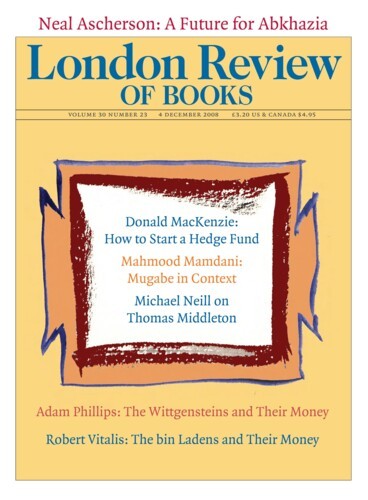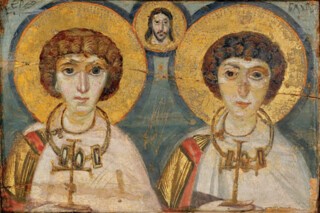The first thing you see in the Byzantium 330-1453 exhibition at the Royal Academy (until 22 March 2009) is one of the last of the objects on display to have been made, a huge 13th or 14th-century chandelier that brilliantly conjures up a sense of an ecclesiastical space. The room full of ivories, rich manuscripts and precious vessels, on the other hand, makes you feel as if you’ve been invited into the most private apartments of the imperial court. The icons that have been brought to London from museums in Ohrid, Belgrade, Mytilene and Athens are all magnificent. Even the fact that most of them have been plated over with a job-lot of utilitarian silver revetment, paid for by later donors, seems less a disfigurement than a reminder that these are working objects, tools for salvation. Nearby, in contrast to the icons, is a child’s woollen hooded top from seventh-century Egypt: the only place in the Byzantine world where climatic conditions could have preserved such an ordinary object, and its presence suggests an everyday world that might otherwise be hard to imagine. The show culminates with the icons from the Monastery of St Catherine at Sinai (such as the one below); the best are those painted in the late 12th century for the monastery’s iconostasis, the screen that separates the sanctuary from the body of the church. They’re worth seeing in London because you can get closer to them, and they are better lit, than they are on the monastery walls.
Unfortunately, the organising idea behind the exhibition is the traditional one: that Byzantium preserved classical art in a Christian form and then passed it on to the West, where it formed one of the taproots of the Renaissance. Part of the problem with this story, as Cyril Mango points out in his brief historical introduction to the catalogue, is that the idea of a single culture defining the period from 330 to 1453 is suspect.* In the fourth, fifth and sixth centuries, the age of Constantine and Justinian, the Roman Empire was a political and economic superpower in a way that the rump state of the seventh century onwards, annually raided by Muslim armies, was not. Most historians use the term ‘Byzantine Empire’ to refer only to this later entity, which recovered some of its power only in the tenth and early 11th centuries. The two massive 11th-century brass doors on display here, strong enough to repel anything but a serious siege, soberly, intricately and expressively decorated, were made in Constantinople for a southern Italian merchant prince. They speak of the commercial and political ties that bound Byzantium to the wider world; but doors like these must have been a common sight in the imperial city, as gateways to the walled compounds of the rich and powerful.
After the loss of Asia Minor to the Turks in the late 11th century, the jaundiced views of 12th-century observers, native and foreign, that this was a gimcrack empire, incapable of defending itself, should not be discounted. Constantine’s empire, which stretched from Hadrian’s Wall to Egypt, had little in common with that of the rulers under whom most of the art exhibited here was created. The claim of the audioguide that ‘for over a thousand years Byzantium was one of the most successful empires the world has ever known’ is simply not true, even if the precise delicacy of the ivory Harbaville Triptych and the Paris Psalter challenge the prevailing view that the tenth-century emperor who commissioned them, Constantine VII Porphyrogenitus, was nothing but a hen-pecked drunk.
There is another story concealed here: Byzantine art as part of a common culture shared by Muslims and Christians, the subjects of emperors, shahs, caliphs and qaghans (the nomad rulers of the steppe). Some of the objects on show hint at it: the painted and gilded bowl decorated with pseudo-Kufic script as well as classical scenes; the fragment of 11th-century red silk from Sion in Switzerland with Persian griffins, or the brazier from Venice in the form of a very unclassical church with griffins and onion domes, both of which were made in Constantinople and are likely to have been loot from the Fourth Crusade; the arabesque motifs on the back of a tenth-century ivory or on the covers of the 12th-century Melisende Psalter. Given that this less eurocentric way of looking at things has been a major theme of recent writing on Byzantine art, not least by Thomas Matthews, who contributes to the catalogue, it’s a pity the exhibition wasn’t curated with it more in mind.
Still, there has been no shortage of exhibitions on Byzantium in recent years and doing something different is not easy, not least because Byzantine art is not a limitless resource, and the number of show-worthy items is more limited still. Most large-scale Byzantine art has been destroyed over the centuries. The smaller objects that have survived are often valuable but don’t necessarily have much visual impact. The Paris Psalter, with its sparkling full-page miniatures in vivid colour, is by far the most impressive product of Byzantine court art to survive, and no exhibition able to draw on international collections would be complete without it. The ninth-century Khludov Psalter is, as ever, open at the folios that show an iconoclast whitewashing an icon of Christ. It is the most accessible image in the volume, and a neat way to tell the story of iconoclasm. There are several 13th-century glazed bowls from excavations in Greece, and again inevitably, we have the famous plate from Corinth showing two lovers in a garden. It may be hard to ring the changes, but that’s no reason not to try.
Send Letters To:
The Editor
London Review of Books,
28 Little Russell Street
London, WC1A 2HN
letters@lrb.co.uk
Please include name, address, and a telephone number.


